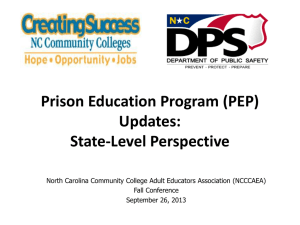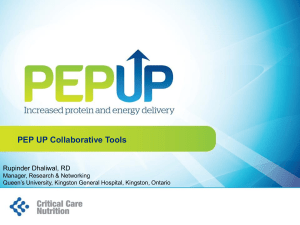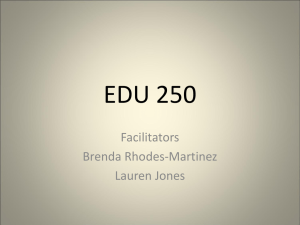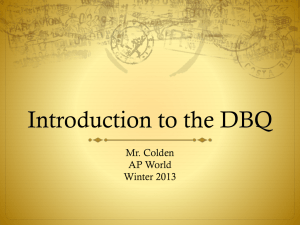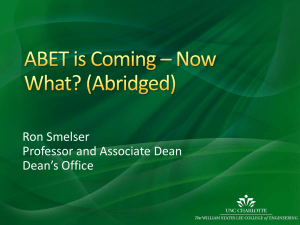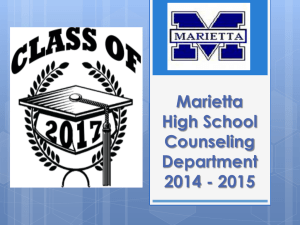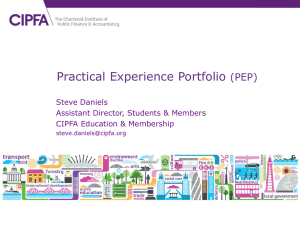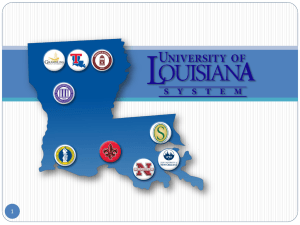PEP - Personal Education Plans - Denver Public Schools Counseling
advertisement
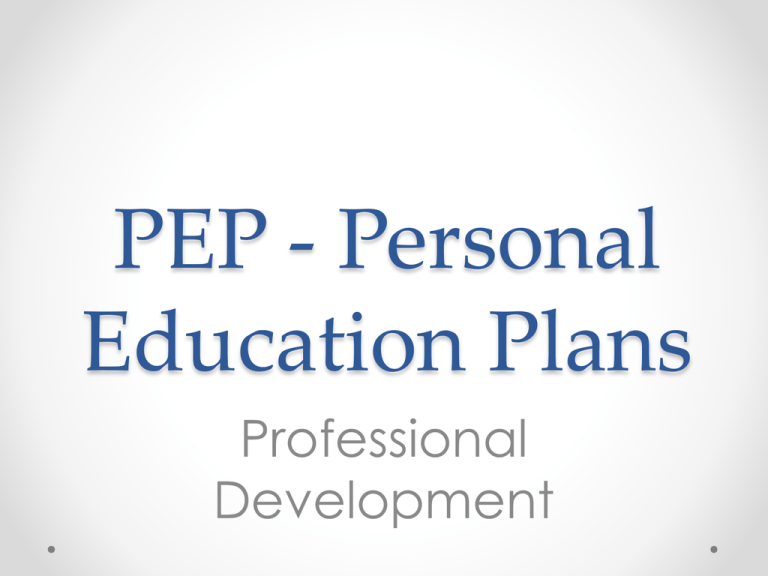
PEP - Personal Education Plans Professional Development SCLT Summer Work Personal & District Values District Values • Excellence • Students first • Integrity • Accountability • Equity • Collaboration • Fun PEP Overview & Compliance What is it really? The Personal Education Plan is a process that students participate in, which results in an actual plan. Process: Grade level required activities using: 1) Naviance 2) CollegeinColorado 3) Guidance Lessons Plan: 1. Career cluster or path goal 2. Post secondary goal 3. 4-year high school plan, including courses What’s new? 1. Increased compliance with ICAP State Requirements 2. Increased Lesson Quality 3. Increased Training and Support ICAP Compliance Why does it matter? Because the ASCA Because we know Because Colorado’s legislature National Model Because the 2009 state of Because the DPS Because Colorado’s legislature passed Because a Personal Because it is the best DPS for School passed laws ICAPs for hasrequiring Individual Colorado’s School the ASCENT legislationFinance reforming Counseling Education Plan is part of secondary students. Colorado Board students hasschool Post to Secondary make how high students can Act requires that sixth grade Student Planning Department ofconcurrent Education’s rules Standards include participate in enrollment DPS’ graduation Readiness plans goals for their that we students open a College In of the programs. In order for afour student to for as theone ICAP law require academic and requirements. th th are futures, even to fulfill. if Colorado account inof order to participate the ASCENT concurrent students incharged 9in through 12 grade components the career planning for enrollment program, they must have begin theplans ICAP process. tothose explore careers, post change. delivery system. an ICAP directly relating to the postall students. secondary education, and high secondary course. school success. Why does it matter? ASCENT law (state) Graduation requirements ICAP law (state) School Finance Act (state) Best practices DPS School Counseling Standards (DPS) Personal Education Plan (PEP) School Board Goals ASCA National Model (DPS) ICAP Standards Grouped into 4 Categories Goal Setting: Career Exploration: * Career or workforce, post-secondary, and academic goals 2.01(1)(a) * Interest surveys 2.01(1)(a) * Career exploration 2.01(1)(a) State ICAP (DPS PEP) Academic Planning: Post-Secondary & Financial Planning: * Intentional 4-Year course plan in alignment with PS and workforce goals 2.01(1)(c) * College applications or alternative applications 2.01(1)(f) * Service Learning opportunities 2.01 (1)(e) * Progress toward securing scholarships, loans, grants, etc. 2.01(1)(h) * Record of remedial and CE courses taken 2.01(1)b), PS courses taken 2.01(1)(g), and student assessment scores 2.01(1)(d) * Understanding of the financial impact of PS education 2.01(1)(i) ICAP/PEP Alignment PEP Categories ICAP Categories (PEP Last Year) (PEP This Year) • Career Exploration • Academic Planning • College Planning • • • • • Career Exploration Academic Planning Post-Secondary & Financial Planning Goal Setting We identified 2 new areas of focus that we were missing: Financial Planning AND Goal Setting 6-8th Scope & Sequence 9-12th Scope & Sequence Data & ICAP Compliance • “District Responsibility” o “The district shall establish specific policies, which must include a method to evaluate the implementation and effectiveness of the standards set forth.” • Data reports will be pulled 2-4 times throughout the year and will be collected via CollegeinColorado and/or Naviance (pay special attention to the yellow boxes) • District and school-specific data is reported to Assistant Superintendents, Instructional Superintendents, and other district personnel, including the school board. • The DPS Board wants to ensure that ALL students have these experiences in compliance with state law. What do all these expectations have in common? ASCENT law (state) Graduation requirements ICAP law (state) School Finance Act (state) Best practices DPS School Counseling Standards (DPS) Personal Education Plan (PEP) School Board Goals ASCA National Model (DPS) They are all EXTERNAL motivators • If only focus on the external demands… o Compliance o Actions, deadlines, requirements o Appearance, o Duty or obligation o What you “should” do or what you’re supposed to do • Feel controlled, trapped, pressured, overwhelmed • Creates resentment, frustration, & disconnect between what say and do • Lack the internal drive to meet the demand Student PEP Comments (Handout) Think-pair-share • Read student comments (side A) o Discuss guiding question • Read student comments (side B) o Discuss guiding question • Compare and contrast groups of comments Student Comments School A • “I don’t know what a PEP is.” • “We haven’t really done a lot with PEP at the sophomore year. It would be better if our counselor would help us so later on we could apply for scholarships and in order for us to succeed.” • “It was helpful but haven’t done much with it. I haven’t really talked about it. They sometimes do announce things about it.” • “I don’t know what this is.” • “I don’t really know.” • “I don’t know what a PEP is.” Guiding Question • What assumptions can you make about this school’s implementation of PEP? • __________________________________________________ __________________________________________________ __________________________________________________ __________________________________________________ Student Comments School B • “The guidance helps keep goals in mind for after high school.” • “A Personal Education Plan is your plans for after high school and your goals.” • “I have worked with my teachers and counselors to find out what I need to do to get into the schools I want with the classes I need and it helped a lot.” • “Yes, it was helpful definitely for my AP classes that I get for college credit.” • “I think that they did a good job on the PEP. They give us a lot of information on colleges that will fit us. They try to put us in the best classes.” • “The guidance helps keep goals in mind for after high school.” Guiding Question • What assumptions can you make about this school’s implementation of PEP? • __________________________________________________ __________________________________________________ __________________________________________________ __________________________________________________ The real question is What do you believe? How To Vote via Texting TIPS 1. Standard texting rates only (worst case US $0.20) 2. We have no access to your phone number 3. Capitalization doesn’t matter, but spaces and spelling do Students will be able to… • Career Exploration & Planning o Understand the value, skill requirements, and habits of work in the 21st century o Match personal interests with career possibilities o Identify a personal career, pathway, or Career Cluster goal • Goal Setting o Learn the process of developing goals and pathways on their journey to career and postsecondary readiness. o Develop the persistence and motivation to overcome barriers to meet goals. • Academic Success & Course Planning o Learn the academic beliefs, behaviors, and performance standards required to be “on-track” for college and career readiness. o Learn the process of intentionally selecting classes to meet high school graduation requirements and choosing co-curricular experiences that align with career and postsecondary path goals. • Postsecondary & Financial Planning o Explore the earning and lifestyle potential of postsecondary education. o Learn the process needed to plan and prepare for a career after high school graduation. This includes understanding how to access and pay for postsecondary education. How important to you believe these outcomes are for all students? (Complete Survey)) My Core Values & Beliefs My Values • Excellence • Hard work • Students first • Integrity My Beliefs 1) Belief that all students must graduate college & career ready, with an understanding of the 21st century college & career reality o Believe that all students can be college–ready (experience at Cole/DSST) o Believe that there are multiple pathways and that all students need the same foundational knowledge and skills to be college AND career ready o Believe the problem is when we fall to one extreme or the other (Not all kids can vs. 4-year college of all) Colleges and Employers want the same qualities and skills in candidates. They also use similar information to evaluate you. College Application Care with which you filled out the application (e.g. no mistakes) Academic Record: courses taken, grades earned Work and Volunteer History Recommendation letters Interview (if applicable) Personal Statement & Essays Job Application Career with which you filled out the application (e.g. no mistakes) Academic Record: courses taken, grades earned Work and Volunteer History References Interview 35 New Reality Taken from “Defining a 21st Century Education by Craig D. Jerald New Reality Taken from “Defining a 21st Century Education by Craig D. Jerald New Reality Taken from “Defining a 21st Century Education by Craig D. Jerald New Reality Taken from “Defining a 21st Century Education by Craig D. Jerald New Reality Taken from “Defining a 21st Century Education by Craig D. Jerald Source: Denver Scholarship Foundation Postsecondary includes… • Post-secondary educational Options o o o o o o o 4-year college or university Community College Trade school Certificate Apprenticeship Internship Military • Choice depends on student and industry • It’s all about completion – multiple pathways Taken from report by Colorado Succeeds, “The Business Case for Education Reform.” In more ways than 1 • http://www.youtube.com/watch?v=spNDLD2KRuA &feature=relmfu (Ed pays) Bachelor’s Degree Reality Check • Bachelor’s degree students’ unemployed or underemployed is estimated at 53.6% (Associated Press, 2012) • “27% of people with post-secondary licenses or certificatescredentials short of an associate’s degree-earn more than the average bachelor’s degree recipient.” (Pathways to Prosperity, 2011) • Demand for middle-skilled professionals is exploding in industries like o o o o o Healthcare Construction Manufacturing Natural resources Mining and installation/repair Average College Debt New Post Grad Reality (they even made a movie about it) • ALL students, (including “college-bound” students) need career path guidance, careerreadiness skills, and an understanding of the 21st century job market. • According to survey conducted by Cuuran Consulting Group (2007), o 75% of those who wanted jobs found jobs within six months of graduation (25% didn’t) o 43% are in a different career field than the one they entered immediately after graduation o 44% are still not sure they are in the right career field Source: Curran Consulting Group: Essential Data on Colleges and Careers, May 7, 2012 by Sheila Curran. Five Year Out Alumni Survey, Class of 2001, Duke University, March, 2007 by Sheila Curran. My Beliefs 2) The importance of non-cognitive factors in student success • Academic Mindset • Academic Responsibility or sense of control • Efforts & Persistence • Academic Behaviors (i.e. Characteristics of Successful Learners) • Learning Strategies Academic Beliefs Growth Mindset and Sense of Personal Control are more closely associated with school performance than test scores (Farrington, Roderick, Allensworth, Nagaoka, Keyes, Johnson, and Beechum, 2012). Research Study by Dweck Fixed Mindset Group Growth Mindset Group Test 1 - 5th Graders were given a puzzle to complete. When they finished, they were told either… “You must be smart (intelligent).” “You must have worked really hard.” Test 2 - Same students were given the choice between a difficult and an easy task. Most chose the easy task. 90% chose the difficult task. They gave up quickly. They worked hard at figuring out the puzzle. Test 4 - Same students then asked if they wanted to see exams of students who did better or worse than them. Wanted to see exams of students who did worse. Wanted to see exams of students who did better. Test 5 - Students were given the original puzzle again to see if they improved. Scores dropped by nearly 20%. Raised average score by 30%. Academic Beliefs Test 3 - Same students were given a difficult (8th g.) test. Academic Beliefs Control Group 1st year college students were shown a video with older college students talking about their academic interests, with no discussion of their grades or class performance. Treatment Group 1st year college students were shown a video with older college students talking about their initial difficulty in college and how their performance and GPA improved over time. Outcome: • One week later – Students in treatment group outscored control group students on practice GRE questions. • One year later - Students in treatment group had higher GPAs than control group by .27 points and were 80% less likely to have dropped out of school. (Wilson and Linville (1982, 1985) Academic Behaviors Attendance, homework, and study habits are more closely related to school performance than test scores. Academic Behaviors • Attendance: o One study followed the 8th grade students with the lowest standardized test scores as they entered HS in Chicago. The lowest scoring students who had less than a week of absences in a semester passed more of the 9th grade courses than students who entered HS with the highest test scores but who missed just one more week of class (Allensworth and Easton, 2007). Academic Behaviors • Homework: o Students with the lowest standardized test scores (i.e. bottom third) who spent over 10 hours per week on homework were able to raise their grades to mostly B’s, the same grade as students with the highest standardized test scores who did not do their homework (Keith, 1982). o Time spent on homework has a positive effect on both grades and standardized test scores. Academic Behaviors • Attendance and study habits strongly predicts student’s grades, even more than standardized test scores or any other student background characteristics. • Grades predict high school and college performance and graduation • Grades even predict people’s future alary. o For each point increase in GPA, men and women earned 20% more money in their jobs 9 years after high school, even after controlling for educational attainment (Miller, 1998). o Why might this be? Because students who attend class and complete their work are likely to practice work habits needed in college as well as in the workforce. Beliefs behind the lessons 3) Defining college & career readiness beginning in middle school o Example: College & Career Readiness Rubric My Beliefs 4) The importance of financial planning (beginning in MS and ending with transition to college) o MS Parent Support and CollegeInvest Grant Matching Opportunities o Summer Melt experience My Beliefs 5) The importance of planning, goal setting, and creating pathways toward goals • GOAL + pathway + motivation = Hope • If roadblock, create new pathway (multiple pathways or routes to goals) GOAL + Pathway + Motivation = HOPE • People who regularly set goals and pathways tend to… o Set learning-based goals within their reach (NOT performancebased goals that may be outside their control) o Have internal desire to learn new skills and master new tasks o Track progress and increase effort with failure or setback o Create new paths to goals when face obstacles or barriers o Use positive self-talk (e.g. “Keep going!” “You can get this done.”) o Receive higher scores on achievement tests, higher overall grade point averages, and higher graduation rates, even when controlling for intelligence o Have increased self-esteem, confidence, and perceived problem-solving abilities and sense of control o Have less anxiety Snyder, C.R., Shorey, H.S., Cheavens, J., Pulvers, K.M., Adams, V.H., and Wiklund, C. (2002). Hope and Academic Success in College, Journal of Educational Psychology, 94, 820-826. My Beliefs 6) The importance of anticipating and overcoming obstacles or barriers Taken from report by Colorado Succeeds, “The Business Case for Education Reform.” College Completion & the Problem of Persistence From Complete College America, Colorado 2011 Break Time What’s new? 1. Increased compliance with ICAP State Requirements 2. Increased Lesson Quality 3. Increased Training and Support Lesson Development & Revision In-depth review: What’s the same? Different? 6-8th Scope & Sequence 9-12th Scope & Sequence Wiki Link • www.dpsk12.org Counseling Department Counseling Resources PEP Information • http://dps-counseling.wikispaces.dpsk12.org/PEP+Resources Lesson Revision: What’s New? • Condensed into 4 lessons per grade per year (exception for 8th grade) • Progressive in nature, not repetitive • Put into ready-to-use classroom PowerPoint presentations for increased graphics and visual instructions • Include interactive websites, assessments, and/or games • Include pre-selected YouTube clips intended to inspire and engage • Include meaningful and instantaneous pre/post assessments You Tube Examples • Education Pays o http://www.youtube.com/watch?v=spNDLD2KRuA&feature=relmfu (Ed pays) • Tips to staying focused on your goals o http://www.youtube.com/watch?v=Gtb5GDkJTig • Famous Failures o http://www.youtube.com/watch?v=zLYECIjmnQs • Note-Taking Tips o http://www.youtube.com/watch?v=9gCrslHx7xA • Intro to Naviance and college options o http://www.youtube.com/watch?v=V8CFuruP08s • HSF video comparing/contrasting life with and without a college degree o http://www.youtube.com/watch?v=FQuR5dMHpPs&feature=youtu.be • Valedictorian speech highlighting scholarships & overcoming obstacles o http://www.youtube.com/watch?v=Q0Wcr82UOsw Interactive student pre/post assessment tools • Promethean board clicker technology o Download CPS at www.einstruction.com • Cell phone voting technology o www.pollseverywhere.com • Create a Google Docs survey o www.drive.google.com Middle School: What’s New? • Middle School (Grades 6-8) o Standards-based report cards and characteristics of successful learners component added to MS success lesson o Research-based personal qualities necessary for college/career readiness, including academic beliefs and behaviors o Goal setting and resume planning components o College costs and financial aid vocabulary o Other deadlines such as transition survey and spreadsheet data collection requirements are included High School: What’s New? • High School (Grades 9-12) PSWR and/or 21st Century Skill component New 10th grade interest/career exploration requirements Ninth grade College EXPO prep Implications of GPA, ACT, Accuplacer, and remediation Introduction to credit recovery options College transition lesson to introduce final steps to enroll in college and prevent the “summer melt” o Transcripts and graduation requirements; Naviance Career and PS Survey; and Naviance 4-year course plan combined into single lesson. o For 9th & 10th grade, this lesson can be used to support class registration to make it relevant. o Other deadlines and requirements such as senior contracts and exit surveys are included o o o o o o Breakout Groups • Breakout Groups 1. Middle Schools 2. 6-12 Schools 3. High Schools • Anticipated Outcomes: o Understand the updates for the 2012-13 Scope & Sequence o Know where to get the resources o Begin to plan for implementation o If not using the lesson plans, what WILL you use? How will you ensure it is a highly engaging, interactive lesson? What’s new? 1. Increased compliance with ICAP State Requirements 2. Increased Lesson Quality 3. Increased Training and Support Training & Support Tools of the Trade • What do you need to know and be able to do in order to effectively implement PEP curriculum for all students? o www.collegeincolorado.org • Holland Types & Career Clusters o http://succeed.naviance.com • MBTI Type Indicator o www.dpsk12.org Departments Counseling Services Counseling Resources PEP Info o www.dpsk12.org Departments Career and Technology Education Plans of Study o Pre/post poll site www.polleverywhere.com o Parent Guide Resource Books Tools to Increase Support 1. Time/Task Analysis 2. Counselor/Administrator Agreement 3. PEP Action Plan for support and coordination (Handout) Time Task Analysis Use of Time Assessment Direct Student Services chool S Counseling Core Curriculum 7-7:15 a.m. 7:16-7:30 a.m. 7:31-7:45 a.m. 7:46-8 a.m. 8:01-8:15 a.m. 8:16-8:30 a.m. 8:31-8:45 a.m. 8:46-9 a.m. 9:01-9:15 a.m. 9:16-9:30 a.m. 9:31-9:45 a.m. 9:46-10 a.m. 10:01-10:15 a.m. 10:16-10:30 a.m. 10:31-10:45 10:46-11 a.m. Individual Student Planning Responsive Services Indirect Student Services Program Management and School Support Program Foundation, Referrals/ Management Consultation/ and Collaboration Accountability air-Share F Responsibility Non SchoolCounseling Tasks on-SchoolN Counseling Tasks Counselor/Administrator Agreement Training & Support Opportunities • Introduction to PEPs (Thurs, Sept 6th) • Naviance Training (Mon, Sept 10th) • School Counseling PD on PEP (Tues or Wed, Sept 11th or 12th) • Career Fair Prep Meeting (Thurs, Sept 13th) • CollegeinColorado Training (Thurs, Sept 13th) • Comprehensive PEP Training (Sat, Sept 22nd) • On-going department meetings End
